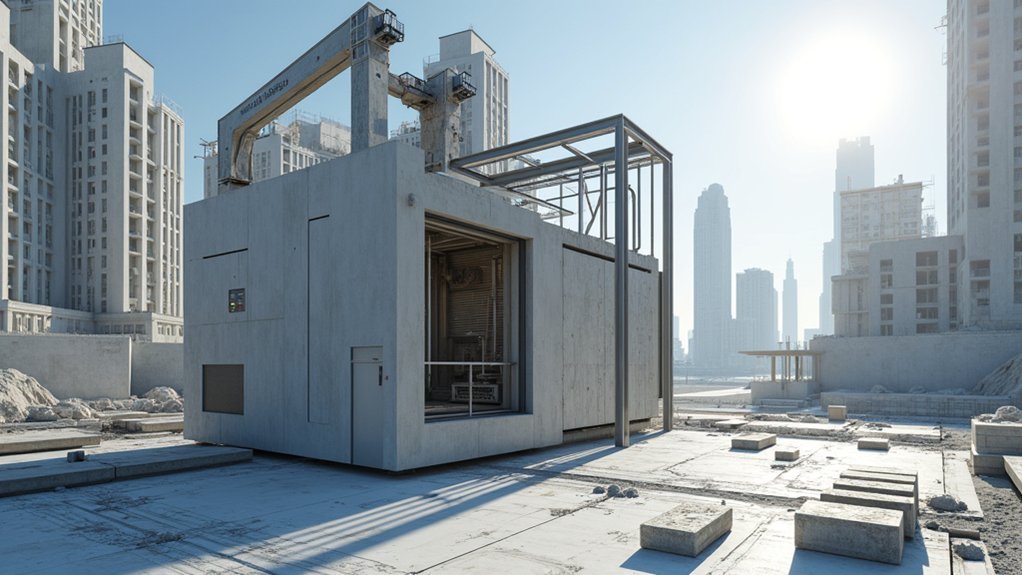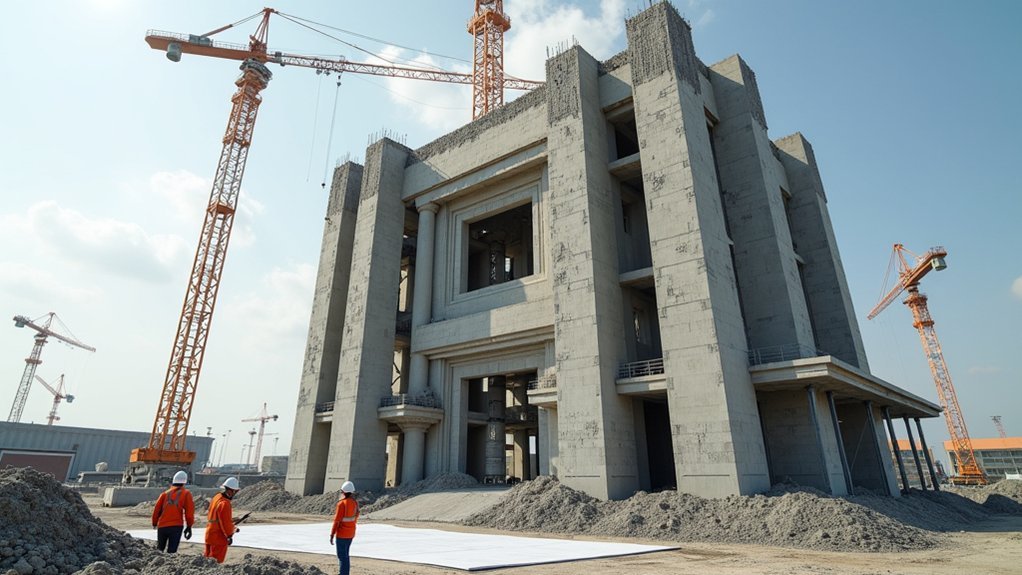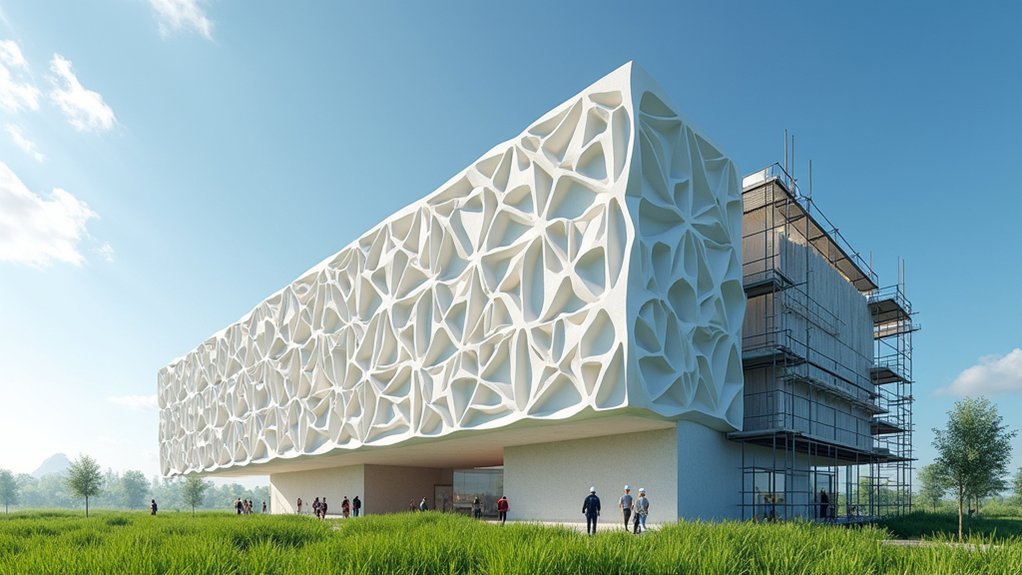Commercial building 3D printing solutions use advanced robotic systems like gantry printers and robotic arms to construct structures layer by layer using materials such as concrete and geopolymers. You’ll benefit from accelerated construction timelines that complete buildings in days rather than months, while reducing labor costs by up to 80% and cutting material waste by 60%. These systems offer enhanced design flexibility for complex architectural features and can handle large-scale projects efficiently. Discover how this technology’s transforming the construction industry below.
How Commercial Building 3D Printing Technology Works

When you’re exploring commercial building 3D printing technology, you’ll discover it operates through large-scale systems like gantry printers and robotic arms that precisely layer materials such as concrete and geopolymer.
The process starts when you create a digital 3D model using CAD or BIM software, which gets sliced into printer-compatible layers. Your chosen construction materials are then deposited layer by layer through extrusion techniques or powder bonding methods in an automated manner, similar to inkjet printing but on a massive scale.
You’ll find quality control integrated throughout, with inspections ensuring structural integrity and design compliance. The technology accommodates advanced materials including sustainable options like recycled plastics, enabling you to construct complex architectural forms for commercial buildings with enhanced customization and environmental benefits.
Types of 3D Printing Systems for Commercial Construction
As you evaluate 3D printing systems for commercial construction, you’ll encounter two primary technologies that dominate the industry: gantry systems and robotic arm systems.
Gantry systems excel at large-scale projects through extrusion methods, efficiently layering materials to construct warehouses and commercial buildings. You’ll find these systems ideal when speed and scale matter most.
When speed and scale are your top priorities, gantry systems deliver unmatched efficiency for large-scale commercial construction projects.
Robotic arm systems offer superior flexibility for complex architectural designs. They adapt to various angles, enabling intricate custom elements and rapid prototyping that gantry systems can’t achieve.
When you integrate CAD and BIM technologies with either system, you’ll enhance precision and accuracy while minimizing waste.
Both systems work with sustainable materials like concrete, geopolymers, and local resources, making your construction processes more cost-effective and environmentally responsible.
Materials and Processes Used in Large-Scale Building Projects

Beyond selecting the right printing system, you’ll need to understand the materials and processes that make large-scale commercial construction possible. Your 3D printing projects will primarily use concrete, geopolymers, and sustainable alternatives like recycled plastics. These materials enhance structural integrity while reducing environmental impact through local natural resources.
You’ll start by creating detailed digital models using CAD or BIM software, then slice them into printable layers. Extrusion remains the most common method, where materials deposit layer by layer through nozzles. Your gantry systems will prove particularly effective for on-site printing of substantial architectural components.
Special mortar mixes enable you to achieve monolithic structures without traditional formwork, improving efficiency and reducing construction waste considerably.
Benefits of 3D Printing for Commercial Real Estate Development
While traditional construction methods lock you into lengthy timelines and inflexible processes, 3D printing transforms commercial real estate development by delivering unprecedented speed, cost savings, and design flexibility.
This technology revolutionizes how you approach commercial applications by dramatically improving project efficiency.
Key benefits include:
- Accelerated construction timelines – Complete structures in days rather than months
- Reduced material waste – Cut waste by up to 60% for enhanced sustainability
- Lower labor costs – Decrease expenses by up to 80% through automation
- Enhanced design flexibility – Create intricate architectural features with rapid plan adjustments
The commercial 3D printing market demonstrates impressive growth, projecting expansion from $190 million in 2021 to $680 million by 2030.
You’ll gain competitive advantages through faster delivery, reduced costs, and innovative design capabilities.
Current Applications and Future Market Trends in Commercial Construction

Today’s commercial construction industry showcases 3D printing across diverse projects, from modular building components to complete structures that redefine what’s possible in development timelines.
You’ll find over 129 3D printed buildings worldwide, including Florida’s Printed Farms Luxury Equestrian Facility spanning 10,105 square feet. The global market growth reflects this momentum, projecting expansion from USD 190 million in 2021 to USD 680 million by 2030.
Market trends indicate you can expect 3D printing to address up to 80% of construction costs while dramatically reducing labor requirements.
Future developments will enable larger structures—buildings reaching five to six floors constructed within a year. This technology grants unprecedented design freedom and efficiency in commercial construction, positioning 3D printing as a transformative force reshaping industry standards.
Frequently Asked Questions
What Is Commercial Use in 3D Printing?
You’re using 3D printing commercially when you’re fabricating office buildings, retail spaces, and warehouses for profit. You’ll reduce construction time, cut material waste by 60%, and potentially save significant costs compared to traditional methods.
How Is 3D Printing Used in the Construction Industry?
You’ll find 3D printing revolutionizes construction by creating walls, foundations, and complex structures using layered concrete. It accelerates timelines, reduces waste by 60%, and enables precise fabrication of entire buildings.
What Are the Methods Used for 3D Printing for Construction?
You’ll find five main 3D printing methods for construction: extrusion using concrete through nozzles, powder bonding techniques, flexible robotic arm systems, large-scale gantry systems, and emerging spray applications for vertical surfaces.
How Is 3D Printing Used in Businesses?
You’ll use 3D printing to create rapid prototypes, custom manufacturing tools, and spare parts on-demand. It’ll reduce your inventory costs, speed up product development, and enable mass customization for your customers.





Leave a Reply